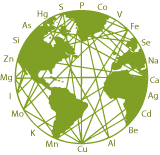Comparing the Metal Concentration in the Nails of Healthy and Cancer Patients Living in the Malwa Region of Punjab, India with a Random European Group – A Follow up Study
British Journal of Medicine and Medical Research, 2015; Vol. 5, Issue 4
Micro Trace Minerals Research Article Abstract:
The cancer prevalence in the Malwa region of Punjab (1089/million/year) is much higher than the national average cancer prevalence in India (800/million/year). In our previous study on hair metal analysis, we located a high metal burden in Punjabi cancer patients and their live-in relatives, suggesting that an excessive metal exposure is a factor in the pathogenesis of cancer. The present study focused on nail metal analysis, a biological material similar to hair. Previously, we had used ICP-MS spectroscopy to confirm high exposures to aluminium (Al), barium (Ba), manganese (Mn), lead (Pb), uranium (U and other metals in the hair of Punjabi cancer patients and their healthy relatives (Blaurock-Busch et al. 2014). In this study, we used nail metal analysis to confirm the results of our previous study.
We compared the nail metal concentration of healthy Punjabis (N=83) with randomly selected healthy Europeans (N=83) and found highly significant differences between the European and Punjabi groups, including the healthy and the cancer groups.In comparison, our European group showed a low percentage (0 to 13%) of pathological values for aluminium (Al), barium (Ba), cadmium (Cd), iron (Fe), manganese (Mn), nickel (Ni), lead (Pb), strontium (Sr), titanium (Ti) and uranium (U), while the healthy Punjabi groups showed between 13% and 99% pathological values for these elements.
The greatest metal burden was found in the breast cancer group (N=13), showing 100% pathological values for Al, Fe, Mn and U. This study supports previous research, which demonstrated a significant metal burden in Punjabi people. Water, soil, and phosphate fertilizers may be the cause of this excessive exposure.
Selenium in Toenails
PREDICTORS OF SELENIUM CONCENTRATION IN HUMAN TOENAILS
D. J. HUNTER1,2, J. S. MORRIS3, C. G. CHUTE2, E. KUSHNER1, G. A. COLDITZ1, M. J. STAMPFER1,2, F. E. SPEIZER1 and W. C. WILLETT1,2,4
- Channing Laboratory, Department of Medicine, Harvard Medical School and Brigham and Women's Hospital Boston, MA
- Department of Epidemiology, Harvard School of Public Health Boston, MA
- Research Reactor Facility, University of Missouri Columbia, MO
- Department of Nutrition, Harvard School of Public Health Boston, MO
To assess the validity of the selenium concentration in human toenails as a measure of selenium intake and to determine other correlates of toenail selenium level, the authors examined toenail selenium within two subgroups of a large cohort study of US women. Mean toenail selenium was higher among 38 consumers of selenium supplements (0.904 µg/g, standard deviation (SD) 0.217) than among 96 nonusers (0.748 µg/g, SD 0.149; p<0.001), and a dose-response relation was observed among supplement users (Spearman's r=0.32; p=0.05). In a second subgroup of 677 women, selenium supplement use was also associated with higher mean toenail selenium (0.906 µg/g, SD 0.214, among 18 users and 0.801 µg/g, SD 0.148, among 659 nonusers; p=0.02), and the dose-response relation was also significant (Spearman's r=0.50; p=0.03). The geographic variation in toenail selenium levels was consistent with the geographic distribution of selenium in forage crops. Toenail selenium declined with age and was significantly reduced among cigarette smokers (mean=0.746, SD 0.124, among 146 current smokers and mean=0.817, SD 0.159, among 311 never smokers; p<0.001) but was not materially affected by alcohol consumption.
Conclusion:
These data provide further evidence for the validity of toenail selenium as a measure of selenium intake and indicate the need to control for age and cigarette smoking in epidemiologic studies of the health effects of selenium exposure.
